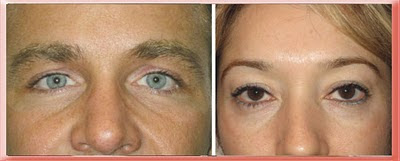Please tweet and retweet
Tweet
In the young individual the transition between lower eyelid and cheek is imperceptible. The dividing line between these areas in older individuals is the nasojugal crease also called the nasojugal groove (term first used in 1961) or tear trough (term first used in 1969). It is an early sign of aging around the eyes, lending a fatigued and aged appearance to the face. As part of the aging process ligaments that fix facial skin to the underlying facial bones thin and lengthen or stretch, facial bones recede back and facial fat shrinks. This results in the drooping of facial skin and appearance of laugh lines, jowls, nasojugal creases, eyelid bags etc.. The skin within the nasojugal groove or crease becomes thinner and/or darker in color than the slightly lower nose or cheek skin. It can also seem deeper or be more visible if there is protrusion of fat into the lower eyelid. The aging process starts near the nose as the tear trough and progresses outwardly towards the same side ear becoming what is called the palpebromalar groove.

